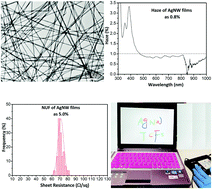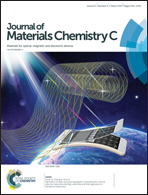Fabrication of silver nanowire transparent conductive films with an ultra-low haze and ultra-high uniformity and their application in transparent electronics†
Abstract
Silver nanowire transparent conductive films are one of the most promising alternatives to indium tin oxide films in the application of touch panels. Low haze and high uniformity are two essential factors for high-end applications of the films. However, the reported haze and uniformity of such kinds of films are still lagging much behind what is required for real-world applications. Herein, the fabrication of silver nanowire transparent conductive films with an ultra-low haze and ultra-high uniformity is reported. DLVO theory is applied to purify silver nanowires and the corresponding ink of the nanowires with narrower size dispersion and less nanoparticle contaminants is formulated for film coating. The fabricated films exhibit a low haze of 0.8% and good uniformity with the non-uniformity factor of 5.0% (defined as the standard deviation of the sheet resistance) at a transmittance of 91.7% (99.4% for the silver nanowire network only without a substrate) and a sheet resistance of 71.2 Ω square−1. The outperforming films are utilized to construct touch-panels with excellent performance for fluent writing. The findings in this work will pave the way for real-world applications of silver nanowire transparent conductive films replacing those of indium tin oxide.

- This article is part of the themed collection: 2017 Journal of Materials Chemistry C HOT Papers


 Please wait while we load your content...
Please wait while we load your content...